It's perfectly normal to feel a bit anxious at this time of the year.
Will Mother Nature be bountiful when it comes to the white stuff? Will Jack Frost ensure it's cold enough for the snow cannons to fire up if Mother Nature isn't in the mood? Or will climate change mess it all up for our supernatural snow providers and deliver us a warm, dry drought when it should be snowing? These are the questions every skier and rider mulls over right before the season starts.
Meteorologists and climatologists try their best to make both short-term and long-range weather forecasts. Snow predictions are often bound to the phases of El Niño and La Nina in the Pacific, but many times, the chaos theory prevails and the season turns out to be opposite of what was predicted.
I personally prefer to rely on more natural signs to tell me whether the snow is coming. Here are a few natural signs of snow that people around the world observe to help determine if it'll be a good winter.
![2014-11-04-SteamboatResort1.jpg]()
PHOTO: Steamboat Resort
1. In the Alps, big flowers are usually good signs.
In autumn, when the blue gentiane flower grows high in the Alpine pastures of Europe, the locals say that a big snow season is coming.
"The Gentianes are higher than we've ever seen them at the moment," said a spokesman from Le Ski (leski.com), a tour company that has operated in the French mountains for 30 years. "So there is 'proof' of what is to come!"
![2014-11-04-GentiansAlps.jpg]()
2. In Scotland, the locals observe snowberries bushes.
Colin Matthew, the former head of ski patrol at CairnGorm Mountain, studies his snowberries bush each autumn to determine how good the snow will be on the slopes above Aviemore in the Highlands.
"In 2009, the snowberries in my garden appeared in early August and were particularly large. They budded and flowered again two or three times during the season, coinciding on each occasion with the massive falls of snow that we experienced that season." What more proof could you possibly need?
3. In France, snow cover can be predicted by the thickness of onion skins.
Around this time of the year, the residents of the Paradiski region get out their micrometres and measure the thickness of onion skins. If it's thick, that's a good sign. If it's thin, expect a mild winter.
4. Ants are the main winter weather predictors in Ischgl, Austria.
Ischgl, Austria has one of the longest seasons in the world from late November to early May. Locals observe the behaviour of ants, who prepare for winter by building big hills. When big hills are built as early as July, then a hard winter is expected.
5. In Italy, it's the bees that are closely observed.
In Cortina, Italy, an abundance of bees in summer means a lot of snow the following winter.
6. Flying creatures are monitored by local ski patrol in Aspen, Colorado.
Black Rosy-Finches are observed nearly 11,000 feet up at the bird feeders on top of Sam's Knob in Snowmass. Prior to big storms, these medium-sized birds come here to gorge themselves. Fortunately, the birds don't eat the moss on the north side, the milkweed, or the furry caterpillars--more local indicators of good snowfall to come.
![2014-11-04-RosyFinchCREDITAspen1.jpg]()
PHOTO: Aspen Snowmass
7. In Canada, wise weather lore is deeply rooted in the culture of the First Nations, the aboriginal peoples who inhabited the regions where the ski slopes now stand for many centuries before the Europeans arrived.
One of the signs members of the First Nations observe is in the coats of horses. Horses shed their summer coats and grow a new, winter coat in the autumn. The earlier the process starts and the thicker that it grows, the colder they expect the weather to be. Apparently, it's triggered by the strength of the sun.
Not quite as ancient but still well-versed in weather lore, Matt Mosteller, vice president of RCR (Resorts of the Canadian Rockies) shares that he reckons the local animal population know best, particularly the local muskrats.
"I have been out on whitewater canoe trips in and around Fernie, British Columbia and when I see muskrats digging a deeper den than normal, it typically means that we are in for an epic winter," said Matt, "It is exciting to see the critters showing signs of more snow to return this winter."
![2014-11-04-SignsofSnowBCStyleCREDITPanoramaSkiResorte1413572124734.jpg]()
PHOTO: Panorama Mountain Village
The good news for 2014-15? One of my favorite signs-- the appearance of early season snow--was already seen widely across western North America a few weeks ago, in late summer! There was, in fact, quite a lot of it, as seen in the above picture from the top of the slopes of British Columbia's Panorama Mountain in early September.
Finally, if you are concerned that it may not be as snowy as you hope this winter, don't feel helpless. There's one more thing you can try...
Sacrifice your retired ski equipment to the old Norse snow god, Ullr. It's probably best to do this in your backyard in the middle of the night, dancing around a bonfire of your old ski kit while chanting, "Snow! Snow! Snow!" (Just kidding!)
![2014-11-04-UllrDayatKimberleyCREDITRCRandTheRealMcKenziePhotographyCopy.jpg]()
PHOTO: The Real McKenzie Photography/RCR
By Patrick Thorne / @Snowhoper
Will Mother Nature be bountiful when it comes to the white stuff? Will Jack Frost ensure it's cold enough for the snow cannons to fire up if Mother Nature isn't in the mood? Or will climate change mess it all up for our supernatural snow providers and deliver us a warm, dry drought when it should be snowing? These are the questions every skier and rider mulls over right before the season starts.
Meteorologists and climatologists try their best to make both short-term and long-range weather forecasts. Snow predictions are often bound to the phases of El Niño and La Nina in the Pacific, but many times, the chaos theory prevails and the season turns out to be opposite of what was predicted.
I personally prefer to rely on more natural signs to tell me whether the snow is coming. Here are a few natural signs of snow that people around the world observe to help determine if it'll be a good winter.
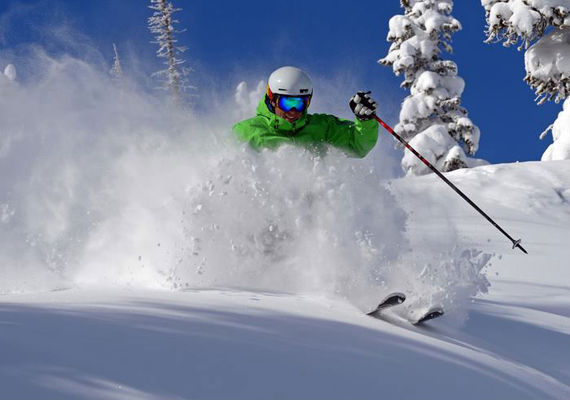
PHOTO: Steamboat Resort
1. In the Alps, big flowers are usually good signs.
In autumn, when the blue gentiane flower grows high in the Alpine pastures of Europe, the locals say that a big snow season is coming.
"The Gentianes are higher than we've ever seen them at the moment," said a spokesman from Le Ski (leski.com), a tour company that has operated in the French mountains for 30 years. "So there is 'proof' of what is to come!"
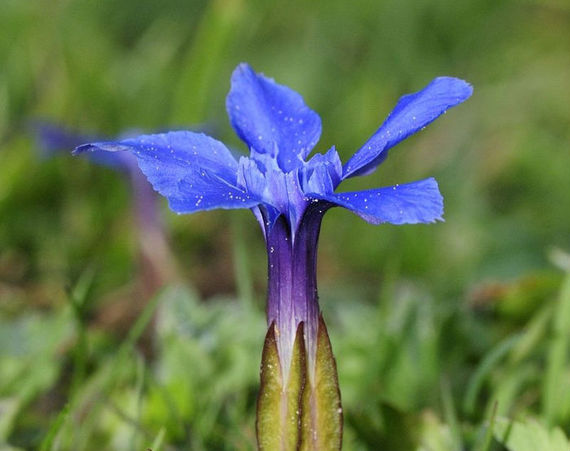
2. In Scotland, the locals observe snowberries bushes.
Colin Matthew, the former head of ski patrol at CairnGorm Mountain, studies his snowberries bush each autumn to determine how good the snow will be on the slopes above Aviemore in the Highlands.
"In 2009, the snowberries in my garden appeared in early August and were particularly large. They budded and flowered again two or three times during the season, coinciding on each occasion with the massive falls of snow that we experienced that season." What more proof could you possibly need?
3. In France, snow cover can be predicted by the thickness of onion skins.
Around this time of the year, the residents of the Paradiski region get out their micrometres and measure the thickness of onion skins. If it's thick, that's a good sign. If it's thin, expect a mild winter.
4. Ants are the main winter weather predictors in Ischgl, Austria.
Ischgl, Austria has one of the longest seasons in the world from late November to early May. Locals observe the behaviour of ants, who prepare for winter by building big hills. When big hills are built as early as July, then a hard winter is expected.
5. In Italy, it's the bees that are closely observed.
In Cortina, Italy, an abundance of bees in summer means a lot of snow the following winter.
6. Flying creatures are monitored by local ski patrol in Aspen, Colorado.
Black Rosy-Finches are observed nearly 11,000 feet up at the bird feeders on top of Sam's Knob in Snowmass. Prior to big storms, these medium-sized birds come here to gorge themselves. Fortunately, the birds don't eat the moss on the north side, the milkweed, or the furry caterpillars--more local indicators of good snowfall to come.
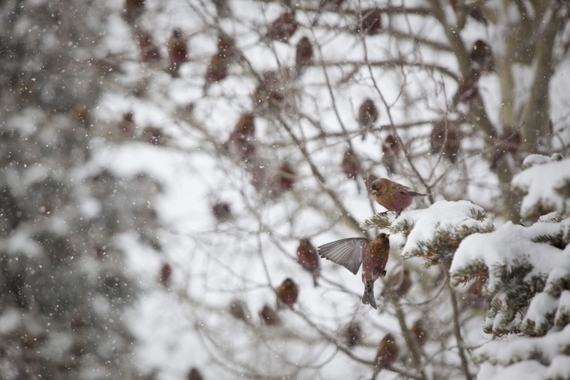
PHOTO: Aspen Snowmass
7. In Canada, wise weather lore is deeply rooted in the culture of the First Nations, the aboriginal peoples who inhabited the regions where the ski slopes now stand for many centuries before the Europeans arrived.
One of the signs members of the First Nations observe is in the coats of horses. Horses shed their summer coats and grow a new, winter coat in the autumn. The earlier the process starts and the thicker that it grows, the colder they expect the weather to be. Apparently, it's triggered by the strength of the sun.
Not quite as ancient but still well-versed in weather lore, Matt Mosteller, vice president of RCR (Resorts of the Canadian Rockies) shares that he reckons the local animal population know best, particularly the local muskrats.
"I have been out on whitewater canoe trips in and around Fernie, British Columbia and when I see muskrats digging a deeper den than normal, it typically means that we are in for an epic winter," said Matt, "It is exciting to see the critters showing signs of more snow to return this winter."
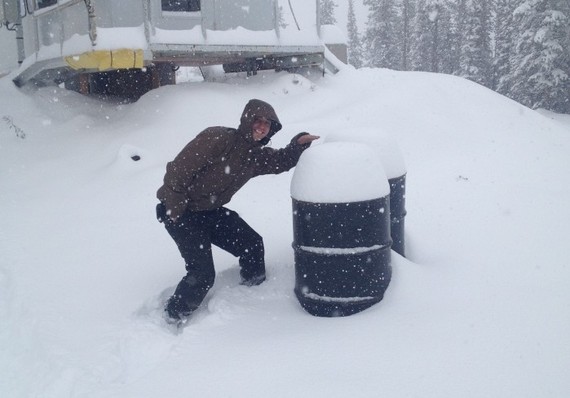
PHOTO: Panorama Mountain Village
The good news for 2014-15? One of my favorite signs-- the appearance of early season snow--was already seen widely across western North America a few weeks ago, in late summer! There was, in fact, quite a lot of it, as seen in the above picture from the top of the slopes of British Columbia's Panorama Mountain in early September.
Finally, if you are concerned that it may not be as snowy as you hope this winter, don't feel helpless. There's one more thing you can try...
Sacrifice your retired ski equipment to the old Norse snow god, Ullr. It's probably best to do this in your backyard in the middle of the night, dancing around a bonfire of your old ski kit while chanting, "Snow! Snow! Snow!" (Just kidding!)
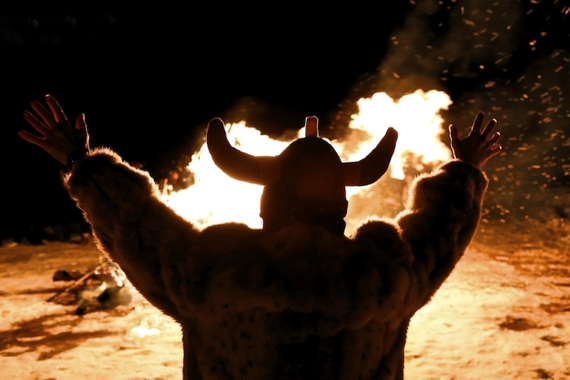
PHOTO: The Real McKenzie Photography/RCR
By Patrick Thorne / @Snowhoper